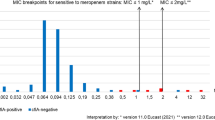Abstract
Susceptibility of strains of Bacteroides fragilis group (1284 isolates from cancerous and noncancerous patients in 1994–2004) showed an increase in resistance toward some antibiotics (by 9 % toward penicillin and 8 % toward clindamycin) compared with the resistance level of 10 years ago. The increase in resistance was not detected in the case of ampicillin + sulbactam and metronidazole.
Similar content being viewed by others
Abbreviations
- BAFR:
-
Bacteroides fragilis (group)
- EUCAST:
-
European Committee on Antimicrobial Susceptibility Testing
- MIC:
-
minimum inhibitory concentration
- NCCLS:
-
National Committee for Clinical Laboratory Standards
- AIN:
-
ampicillin + sulbactam
- CLI:
-
clindamycin
- MET:
-
metronidazole
- PEN(s):
-
penicillin(s)
- BADI:
-
Bacteroides distasonis
- BAEG:
-
Bacteroides eggerthi
- BAFR:
-
Bacteroides fragilis
- BAOV:
-
Bacteroides ovatus
- BATH:
-
Bacteroides thetaiotaomicron
- BAVU:
-
Bacteroides vulgatus
References
Aldridge K.E., Ashcraft D., Cambre K., Pierson C.L., Jenkins S.G., Rosenblatt J.E.: Multicenter survey of the changing in vitro antimicrobial suceptibilities of clinical isolates of Bacteroides fragilis group, Prevotella, Fusobacterrium, Porphyromonas and Peptostreptococcus species. Antimicrob.Agents Chemother. 45, 1238–1243 (2001).
Betriu C., Campos E., Cabronero C., Rodriguez-Avial C., Picazo J.J.: Susceptibility of species of the Bacteroides fragilis group to 10 antimicrobial agents. Antimicrob.Agents Chemother. 44, 671–673 (1990).
Brazier J.S., Stubs S.T., Duerden B.I.: Metronidazole resistance among clinical isolates belonging to the Bacteroides fragilis group: time to be concerned? J.Antimicrob.Chemother. 44, 580–581 (1999).
Breuil J., Dublanchet A., Truffaut N., Sebald M.: Transferable 5-nitroimidazole resistance in the Bacteroides fragilis group. Plasmid 21, 151–154 (1989).
Eady E.A., Jones C.E., Tipper J.I., Cove J.H., Cunliffe W.J., Layton A.M.: Antibiotic resistant propionibacteria in acne: need for policies to modify antibiotic usage. Brit.Med.J. 306, 555–556 (1993).
Edwards D.I.: Resistance to nitroimidazoles in anaerobes, pp. 437–448 in Anaerobic Pathogens (A.R. Ely, K.W. Bennet, Eds). Academic Press, Shefield (UK) 1997.
EUCAST (European Committee on Antimicrobial Susceptibility Testing): Antimicrobial wild type MIC distributions of microorganism; http://www.srga.org/eucastwt/WT_EUCAST.htm (2007).
Freeman C., Dklutman N.E., Lamp K.: Metronidazole — a therapeutic review and update. Drugs 54, 679–708 (1997).
Haggoud A., Ait M’Hand R., Eysset G.E., M’Daghri N., Benbachir M., Moummi M.: Prevalence and characteristic of nim genes encoding 5-nitroimidazole resistance among Bacteroides fragilis strains isolated in Morocco. Microb.Drug Resist. 7, 177–181 (2001).
Hecht D.W.: Resistance trends in anaerobic bacteria. Clin.Microbiol.Newslett. 22, 41–44 (2001).
Hedberg M., Nord C.E. and ESCMID Study Group on Antimicrobial Resistance in Anaerobic Bacteria (G. Feierl, M. Marina, S. Kalenic, D. Chmelař, A. Bremmelgaard, J. Brazier, H. Jousimies-Somer, L. Dubreuil, A. Lozniewski, F. Mory, M. Claros, E. Bezirtzoglou, Z. Lajos, E. Nagy, R. Todorova, K.G. Kristinsson, M. Grazia Menozzi, H. Endtz, F. Meisel-Mikolajczyk, J. Kolman, J. Vila, C. Jarstrand, R. Zbinden): Antimicrobial susceptibility of Bacteroides fragilis group isolates in Europe. Clin.Microbiol.Infect. 9, 475–488 (2003).
Leyden J.J., Mcginley K.J., Cavalieri S., Webster C.F., Mells O.H., Kligman A.M.: Propionibacterium acnes resistance to antibiotics in acne patients. J.Am.Acad.Dermatol. 8, 41–45 (1993).
NCCLS (National Committee for Clinical Laboratory Standards): Methods for antimicrobial susceptibility testing of anaerobic bacteria, 6th ed. Approved Standard M-11-A6. Wayne (USA) 2004.
O’Donoghue M.A., Potter J., Allen K.: Metronidazole-resistant Bacteroides fragilis wound infection. J.Infectol. 25, 211–214 (1992).
Oteo R., Aracil B., Aloe J.I., Gómez-Garces J.L.: High prevalence of resistance to clindamycin in Bacteroides fragilis group isolates. J.Antimicrob.Chemother. 45, 691–693 (2000).
Phillips I., King A., Nord C.E., Hoffstedt B.: Antibiotic sensitivity of the Bacteroides fragilis group in Europe. Eur.J.Clin.Microbiol. Infect.Dis. 11, 292–304 (1992).
Podglajen J., Breuil J., Collatz E.: Insertion of a novel DNA sequence, IS1186 upstream of the silent carbapenemase general cfiA, promotes expresion of carbapenem resistance in clinical isolates of Bacteroides fragilis. Mol.Microbiol. 12, 105–114 (1994).
Ross J.I., Eady E.A., Cove J.H., Jones C.E., Ratyal A.H., Miller Y.W., Vyakrnam S., Cunliffe W.J.: Clinical resistance to erythromycin and clindamycin in cutaneous propionibacteria isolated from acne patients is associated with mutation in 23S rRNA. Antimicrob.Agents Chemother. 41, 1162–1165 (1997).
Snydman D.R., Mcdermott L., Cuchural G.J. Jr., Hecht D.W., Iannini P.B., Harrell L.J., Jenkins S.G., O’Keefe J.P., Pierson C.L., Rihs J.D., Yu V.L., Finegold S.M., Gorbach S.L.: Analysis of trend in antimicrobial resistance patterns among clinical isolates of Bacteroides fragilis group species from 1990 to 1994. Clin.Infect.Dis. 23 (Suppl. 1), S54–S65 (1996).
Snydman D.R., Jacobus N.V., McDermott L.A., Supran S., Cuchural J.G. Jr., Finegold S., Harrell L., Hecht D.W., Iannini P., Jenkins S., Pierson C., Rihs J., Gorbach S.L.: Multicenter study of in vitro susceptibility of the Bacteroides fragilis group with comparison of resistance trends from 1995 to 1996, with comparison of resistance trends from 1990 to 1996. Antimicrob.Agents Chemother. 43, 2417–2422 (1999).
Urbášková P.: Resistance of Bacteria toward Antibiotics. (InCzech) Trios Publishing, Prague 1997.
Willis A.T., Ferguson J.R., Jones P.H.: Metronidazole in prevention and treatment of Bacteroides infections after appendicectomy. Brit.Med.J. 1, 318–321 (1976).
Author information
Authors and Affiliations
Corresponding author
Rights and permissions
About this article
Cite this article
Chmelař, D. In Vitro susceptibility to selected antibiotics in bacteria of the Bacteroides fragilis group. Folia Microbiol 54, 353–358 (2009). https://doi.org/10.1007/s12223-009-0050-5
Received:
Revised:
Published:
Issue Date:
DOI: https://doi.org/10.1007/s12223-009-0050-5



